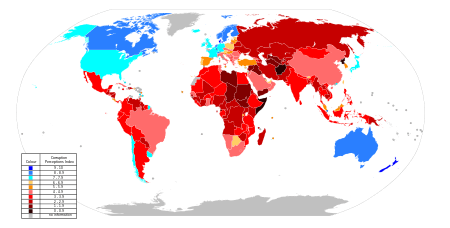Corruption in the Philippines

| Political corruption |
|---|
| Concepts |
| Corruption by country |
| Europe |
| Asia |
| Africa |
| North America |
| South America |
| Oceania and the Pacific |
| Transcontinental countries |
Philippines suffers from widespread corruption.[1] Means of corruption include graft, bribery, embezzlement, backdoor deals, nepotism, and patronage.[2]
Corruption levels
According to a World Bank study in 2008, corruption in the Philippines is considered to be the worst among East Asia’s leading economies and the country has sunk even lower among those seen to be lagging in governance reforms.[3] The 2009 Corruption Perceptions Index published by global watchdog Transparency International, showed that the situation in the country had improved slightly but still remained serious.[4]
The Philippines ranked 3rd among 180 countries included in the index, up from its previous 141st ranking in 2008. The nation scored 2.4 in the TI index, compared to 2.3 in 2008, which ranked it equal to Pakistan, Bangladesh and the Baltic state of Belarus.[5]
Corruption exists in all levels of the government, especially among high-level civil servants, according to the US Department of State Investment Climate Statement 2013.[6] Companies generally have little confidence in the Philippine judicial system, and this is due to the allegedly incompetent court personnel, corruption and long delays of court cases.[7]
Decline
As of 2012, the Philippines came in at 105 with a 3.4 CPI in Transparency International's list that ranks 176 (tied with Algeria, Armenia, Bolivia, Gambia, Kosovo, Mali, and Mexico), countries and territories based on how corrupt their public sector is perceived to be.
This is better than the Philippines' 129th out of 178,ranking in 2011 with a 2.6 CPI, in Transparency International's list. The CPI score indicates the perceived level of public sector corruption on a scale of 0 - 10, where 0 means that a country is perceived as highly corrupt and 10 means that a country is perceived as very clean.
Transparency International-Philippines said some of the factors that contributed to the Philippines' (2.6) slight jump are the improvement in government service, and cutting red tape.[8]
Statistical evaluations
For the list of rankings per country per year, please see http://www.transparency.org/research/cpi/overview
Political nepotism
The Philippine political arena is mainly arranged and operated by families or alliances of families, rather than organised around the voting for political parties.[9]
See also
- Human rights in the Philippines
- Extrajudicial killings and forced disappearances in the Philippines
- List of political scandals in the Philippines
- Philippines Truth Commission
General:
References
- ↑ Jurado, Emil (March 12, 2010). "The fourth most corrupt nation". Manila Standard Today. Retrieved August 21, 2010.
- ↑ Conde, Carlos (March 13, 2007). "Philippines most corrupt, survey says". The New York Times. Retrieved August 21, 2010.
- ↑ Dumlao, Doris (June 25, 2008). "WB: Corruption in RP worst in East Asia". Philippine Daily Inquirer. Retrieved August 21, 2010.
- ↑ Dizon, David (November 18, 2009). "RP corruption ranking improves slightly: TI". ABS-CBN News. Retrieved August 21, 2010.
- ↑ Dizon, David (November 18, 2009). "RP corruption ranking improves slightly: TI". ABS-CBN News. Retrieved August 21, 2010.
- ↑ Investment Climate Statement 2013 from the US Department of State
- ↑ Snapshot of the Philippines Country Profile in Business Anti-Corruption Portal
- ↑ http://www.abs-cbnnews.com/nation/06/27/12/ph-corruption-going-going-not-yet-gone
- ↑ Coronel, Chua, Rimban, & Cruz The Rulemakers Philippine Center for Investigative Journalism (2007); p.49
Further reading
| |||||||||||||||||||||||||||||||||||||||||||||
| ||||||||||||||
